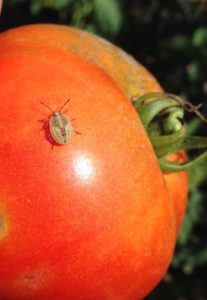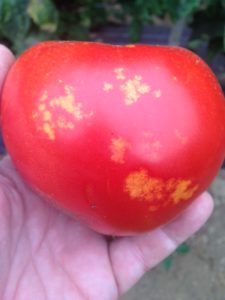Sweet Corn
European corn borer (ECB) moth activity is extremely low in areas where blacklight traps are operating in the northern and central counties. Feeding in whorl and pre-tassel stage corn has increased slightly over the past week, but only in a few areas. Many plantings exhibiting no ECB injury at all. While ECB has become something of a local phenomenon in NJ, growers should not assume that feeding is below economic levels in their area.
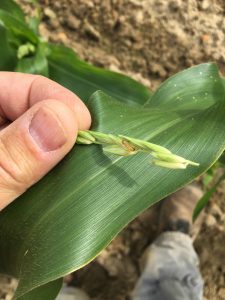 Look for the characteristic “shot-hole” type of feeding (photo below at right) and consider treating when infested plants exceed 12% in a 50 plant sample. As plantings proceed to the pre-tassel stage, ECB larvae may be found in emerging tassels (see photo at left). It is a good idea to treat individual plantings as they move into the full tassel/first silk stage one time. This eliminates any ECB larvae that have emerged with the tassels as they begin to move down the stalk to re-enter near developing ears.
Look for the characteristic “shot-hole” type of feeding (photo below at right) and consider treating when infested plants exceed 12% in a 50 plant sample. As plantings proceed to the pre-tassel stage, ECB larvae may be found in emerging tassels (see photo at left). It is a good idea to treat individual plantings as they move into the full tassel/first silk stage one time. This eliminates any ECB larvae that have emerged with the tassels as they begin to move down the stalk to re-enter near developing ears.
Useful insecticides for this particular application include synthetic 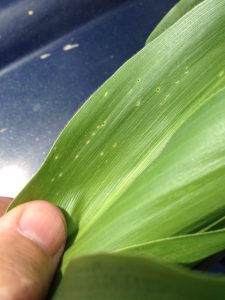 pyrethroids (IRAC Grp 3), spinosyns (including OMRI approved Entrust) IRAC Grp 5), and diamides such as Coragen or Vantacor (IRAC Grp 28) or materials such as Besiege which include the active ingredient in Coragen. Synthetic pyrethroids alone should NOT be used for corn earworm (CEW) protection on silking corn. Control with these materials is very inconsistent.
pyrethroids (IRAC Grp 3), spinosyns (including OMRI approved Entrust) IRAC Grp 5), and diamides such as Coragen or Vantacor (IRAC Grp 28) or materials such as Besiege which include the active ingredient in Coragen. Synthetic pyrethroids alone should NOT be used for corn earworm (CEW) protection on silking corn. Control with these materials is very inconsistent.
The highest nightly trap catches of ECB for the week ending 7/05/23 are as follows:
| Allentown 1 | Hillsborough 1 |
| Asbury 1 | Milford 1 |
| Bellemeade 1 | Lawrenceville 1 |
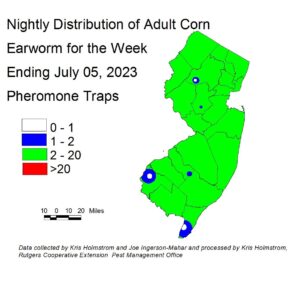 Corn earworm (CEW) moths captures from northern and central blacklight traps remain low, with continued higher catches in the Holmdel-Adelphia region of Monmouth County. Pheromone trap information is available from all northern and central sites, with increasing input from southern New Jersey. We will use a combination of pheromone and blacklight trap types to derive silk spray schedules by region. The numbers from reporting pheromone traps have again declined slightly over the past week, although this has done little to change spray schedules. At present, highest activity near silking corn that we are aware of is in Cumberland and Warren counties (see CEW pheromone map at right). Silking corn is at risk of CEW infestation at this time. Green areas on the map correspond to a 4-5 day schedule. Be sure to access information from this publication in the upcoming weeks to determine how frequently you should treat silking sweet corn to protect it from CEW infestation.
Corn earworm (CEW) moths captures from northern and central blacklight traps remain low, with continued higher catches in the Holmdel-Adelphia region of Monmouth County. Pheromone trap information is available from all northern and central sites, with increasing input from southern New Jersey. We will use a combination of pheromone and blacklight trap types to derive silk spray schedules by region. The numbers from reporting pheromone traps have again declined slightly over the past week, although this has done little to change spray schedules. At present, highest activity near silking corn that we are aware of is in Cumberland and Warren counties (see CEW pheromone map at right). Silking corn is at risk of CEW infestation at this time. Green areas on the map correspond to a 4-5 day schedule. Be sure to access information from this publication in the upcoming weeks to determine how frequently you should treat silking sweet corn to protect it from CEW infestation.
The highest nightly blacklight trap catches of CEW for the week ending 7/05/23 are as follows:
| Matawan 3 | Georgetown 1 |
| Farmingdale 2 | Milltown 1 |
| Allentown 1 | Morristown 1 |
| Denville 1 | Port Murray 1 |
The highest nightly pheromone trap catches of CEW for the week ending 7/05/23 are as follows:
| Allamuchy 16 | South Branch 7 | Dayton 4 |
| East Vineland 16 | Springdale 6 | Snyder Farm (Hunterdon) 4 |
| Tabernacle 8 | Califon 5 | Farmingdale 4 |
| Georgetown 7 | Berlin 4 | Matawan 4 |
Silking Spray Schedules*:
South – 4 days
Central – 4-5 days
North – 5 days
*These recommendations are based on regional catches. Adhere to tighter spray schedules if indicated by local trap catches. Synthetic pyrethroids alone should NOT be used for corn earworm (CEW) protection on silking corn, or for fall armyworm (FAW) management at any stage. Control with these materials is very inconsistent.
Peppers
The Rutgers Vegetable IPM Program has a limited number of pepper weevil (PW) trap kits that can be made available to commercial growers in the counties of: Atlantic, Camden, Cumberland and Salem. These kits include lures, sticky cards and mounting equipment. Growers will deploy and check their own traps. Please, commercial growers only. If interested, contact Joseph Ingerson-Mahar via email: Mahar@sebs.rutgers.edu or phone/text: 856-889-5718.
Tomatoes
This is the time of the season when native brown stink bugs become active in tomato fields. These true bugs (see photo of Euschistus sp. nymph below at left), move into irrigated tomato fields as forage in the surrounding environment dries out. Feeding results in “cloudy spot” (see photo at right below). Increases in stink bug injury are often found by crews picking the fruit. Growers should consider 1-2 insecticide applications to limit fruit injury if this damage is increasing in harvested fruit. If actively scouting fields, insecticides should be considered if stink bug adults, nymphs or new fruit injury is found in 2 or more sample sites in a 10 site sample. Insecticides that are effective on stink bugs include pyrethroids and neonicotinoids (see Tomato Section from the 2022-23 Guide), so care should be taken to avoid contact with foraging bees.
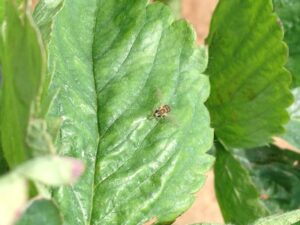
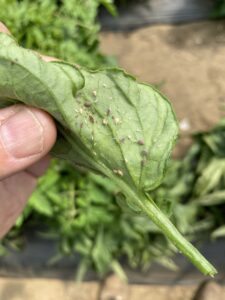 Aphid populations in tomato high tunnels are unusually high this season. This is likely due to unseasonably cool weather throughout the spring resulting in growers keeping the tunnels closed to preserve heat. As such, predators (mainly syrphid flies – photo at upper right) and parasites (aphidius wasps – photo of aphid mummies at left) got a later start inside. In a few cases, populations have risen to levels that cause droppings to make fruit sticky (photo at lower right), warranting an insecticide treatment. If an insecticide application is determined to be necessary, try to use materials that are less disruptive to beneficial insects. The bee sensitivity rating for insecticides in the Tomato Section of the 2022-23 Commercial Veg. Recs. is a good proxy for impact on beneficial insects in general. Recommended insecticides for aphids may be found in the same place.
Aphid populations in tomato high tunnels are unusually high this season. This is likely due to unseasonably cool weather throughout the spring resulting in growers keeping the tunnels closed to preserve heat. As such, predators (mainly syrphid flies – photo at upper right) and parasites (aphidius wasps – photo of aphid mummies at left) got a later start inside. In a few cases, populations have risen to levels that cause droppings to make fruit sticky (photo at lower right), warranting an insecticide treatment. If an insecticide application is determined to be necessary, try to use materials that are less disruptive to beneficial insects. The bee sensitivity rating for insecticides in the Tomato Section of the 2022-23 Commercial Veg. Recs. is a good proxy for impact on beneficial insects in general. Recommended insecticides for aphids may be found in the same place.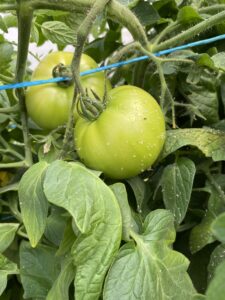
Cucurbit Downy Mildew
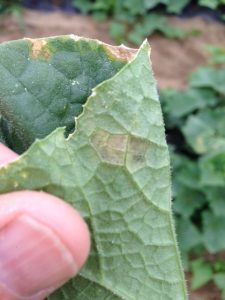
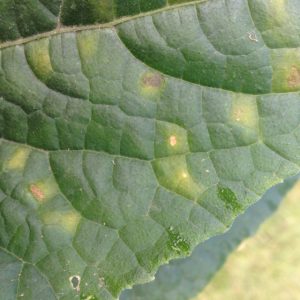 Cucurbit downy mildew has been detected on cucumbers in several parts of southern New Jersey recently. All cucumber and cantaloupe plantings should be protected at this time. Useful materials for CDM may be found in the Cucumber Section of the 2022/23 Commercial Vegetable Production Recommendations. A sentinel plot is established at Snyder Farm in Hunterdon County. This plot, consisting of pumpkin, watermelon, cantaloupe, butternut, acorn, cucumber and kabocha squash will be used to indicate the presence of cucurbit downy mildew in the region, and what crops are affected. As of 7/05/23, no CDM was detected on any host crop in this plot in Hunterdon County. For regional information on this important disease, see the Cucurbit Downy Mildew webpage: http://cdm.ipmpipe.org/. Note that the forecast component of this site is not active this season. However, reports of CDM can still be reported on the site, and may appear on the homepage map down to county level with associated host information. It appears that fewer incidents of CDM are being reported on the site than would be expected. Therefore, it is critical that growers subscribe to the Vegetable Crops edition of the Plant and Pest Advisory in order to receive the most current information on outbreaks from Dr. Andy Wyenandt. Heavy rains and prolonged damp conditions this week favor arrival and spread of this disease. All growers should be checking potential host crops at least once a week for signs of infection. Symptoms on the upper leaf surface are yellow lesions bordered by leaf veins (upper right photo), while on the lower surface, dark sporulation may be found (upper left photo).
Cucurbit downy mildew has been detected on cucumbers in several parts of southern New Jersey recently. All cucumber and cantaloupe plantings should be protected at this time. Useful materials for CDM may be found in the Cucumber Section of the 2022/23 Commercial Vegetable Production Recommendations. A sentinel plot is established at Snyder Farm in Hunterdon County. This plot, consisting of pumpkin, watermelon, cantaloupe, butternut, acorn, cucumber and kabocha squash will be used to indicate the presence of cucurbit downy mildew in the region, and what crops are affected. As of 7/05/23, no CDM was detected on any host crop in this plot in Hunterdon County. For regional information on this important disease, see the Cucurbit Downy Mildew webpage: http://cdm.ipmpipe.org/. Note that the forecast component of this site is not active this season. However, reports of CDM can still be reported on the site, and may appear on the homepage map down to county level with associated host information. It appears that fewer incidents of CDM are being reported on the site than would be expected. Therefore, it is critical that growers subscribe to the Vegetable Crops edition of the Plant and Pest Advisory in order to receive the most current information on outbreaks from Dr. Andy Wyenandt. Heavy rains and prolonged damp conditions this week favor arrival and spread of this disease. All growers should be checking potential host crops at least once a week for signs of infection. Symptoms on the upper leaf surface are yellow lesions bordered by leaf veins (upper right photo), while on the lower surface, dark sporulation may be found (upper left photo).
Pumpkins and Winter Squash
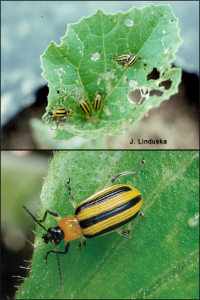 As seedlings emerge, it is critical that they be protected from striped cucumber beetles. These beetles (see photos at left) are attracted to plant chemicals found in leaves, and particularly in the seed leaves. As they feed, they can transmit bacterial wilt to the plants. Heavy feeding can dry out young plants as well. Many commercial varieties come with a seed treatment that includes a neonicotinoid (IRAC 4A) insecticide. This protects the seedlings in the critical 0-4 true leaf stage. Seeds for organic production and some more obscure gourd seeds are not treated and are at risk immediately upon emergence. Rotation away from cucurbit fields helps to limit population buildup locally. Destroy crops immediately upon the end of their useful life. Row covers may be useful in protecting the 0-4 true leaf stage plants in organic production. Scout fields weekly, checking 5 consecutive plants each in 10 random locations. Consider treating for cucumber beetles if they are found actively feeding in 5 or more of the 10 sites. It is unlikely that this threshold will be met if treated seed was planted. After plants begin to run, cucumber beetle feeding is much less important because the plants have developed enough mass to limit the impact of any bacterial infection. Cucumber beetles become a significant pest again later in the season, when they can return to feed on the rinds of developing fruit. Insecticides useful for control of this pest include synthetic pyrethroids (IRAC 3A), diamides (IRAC 28) and neonicotinoids (IRAC 4A), and are found in the Pumpkin and Winter Squash Section of the 2022/23 Commercial Vegetable Recommendations. It is critical to avoid bee exposure with most insecticidal sprays. Evening applications will avoid most bees as they do not forage at that time.
As seedlings emerge, it is critical that they be protected from striped cucumber beetles. These beetles (see photos at left) are attracted to plant chemicals found in leaves, and particularly in the seed leaves. As they feed, they can transmit bacterial wilt to the plants. Heavy feeding can dry out young plants as well. Many commercial varieties come with a seed treatment that includes a neonicotinoid (IRAC 4A) insecticide. This protects the seedlings in the critical 0-4 true leaf stage. Seeds for organic production and some more obscure gourd seeds are not treated and are at risk immediately upon emergence. Rotation away from cucurbit fields helps to limit population buildup locally. Destroy crops immediately upon the end of their useful life. Row covers may be useful in protecting the 0-4 true leaf stage plants in organic production. Scout fields weekly, checking 5 consecutive plants each in 10 random locations. Consider treating for cucumber beetles if they are found actively feeding in 5 or more of the 10 sites. It is unlikely that this threshold will be met if treated seed was planted. After plants begin to run, cucumber beetle feeding is much less important because the plants have developed enough mass to limit the impact of any bacterial infection. Cucumber beetles become a significant pest again later in the season, when they can return to feed on the rinds of developing fruit. Insecticides useful for control of this pest include synthetic pyrethroids (IRAC 3A), diamides (IRAC 28) and neonicotinoids (IRAC 4A), and are found in the Pumpkin and Winter Squash Section of the 2022/23 Commercial Vegetable Recommendations. It is critical to avoid bee exposure with most insecticidal sprays. Evening applications will avoid most bees as they do not forage at that time.
Thank you!
The Vegetable IPM Program wishes to thank the following Field Technicians, without whom much of the information presented weekly here would not be available:
Samantha “Sam” Cioppio
Lei Huang
Kaitlyn Morin
